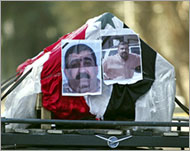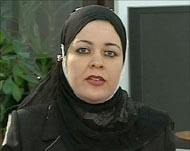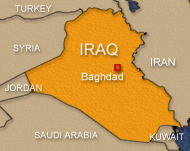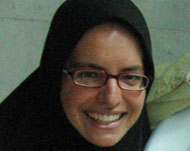Iraq war deadliest for journalists
The war in Iraq has proved to be the deadliest for journalists since World War II, according to Reporters Without Borders, a media advocacy group.

In a report released on Monday, the third anniversary of the US-led invasion of Iraq, the Paris-based organisation said 86 journalists and media assistants have been killed in Iraq since the war began on 20 March 2003.
This is more than the number killed during 20 years of war in Vietnam or the civil war in Algeria.
The group said it was difficult to calculate a comparable number for World War II, partly because tallies at the time did not include staff members such as translators or drivers.
Iraq is also one of the world’s biggest marketplaces for hostages, with 38 journalists kidnapped in three years, the report said.
Five of them were executed. Three – Jill Carroll, Reem Zeid and Marwan Khazaal – are still being held by their abductors.
More than half of the journalists killed in Iraq have been deliberately targeted, Reporters Without Borders said, adding that “the rate was much higher than in previous wars” where indiscriminate attacks and stray bullets were the main causes of death.
Seventy-seven per cent of those killed were Iraqis, many while working for foreign media in the country, the report said.
Indiscriminate
The report further noted that nationality is not a determining factor and in no case affords journalists any protection.
Journalists of 14 different nationalities have died during the war. Four of them were American and one was British.
 |
|
Iraqi journalists have been the |
“So the widespread concern when the war began that American and British journalists and those from other coalition-member countries would be the most exposed turned out to be unfounded,” the report said.
One of the reasons, though, for this situation is the radical security measures adopted by most of the US and British news media operating in Iraq.
These journalists, said the report, have had to adapt their work to the constraints of armoured vehicles, bodyguards and very few excursions.
In most cases, the only contact with the local population is conducted by Iraqi employees, the report said.
Large swaths of Iraqi territory are no longer covered by the foreign press.
Targets
More than 67% of the journalists killed were working for television stations or a TV news agency, and 33% for the print media. Surprisingly, radio journalists have been spared, Reporters Without Borders said.
Forty-one different media have had employees killed in Iraq.
The worst-hit has been the national television station, Al-Iraqiya, with 12 of its journalists and media assistants killed in the past three years.
 |
|
Atwar Bahjat was killed just after |
Al-Iraqiya, the report noted, is part of the Iraqi Media Network (IMN), which was created and funded by the Pentagon.
“This group has since been transferred to the Iraqi authorities and the station is now supervised by an independent board of governors.”
Al-Arabiya, the Emirates-based, pan-Arab TV station, has had six of its employees killed, making it the worst-hit foreign news organisation.
Tariq Ayoub, a journalist with Aljazeera, was killed in a US missile strike on 8 April 2003 in Baghdad and Rachid Hamil Wali, a media assistant with the channel, was killed on 21 May 2004.
With four employees killed, the British news agency Reuters is the worst-hit Western news organisation.
The newspaper to have suffered most is the state-owned daily Al-Sabah, with four employees killed. This newspaper is part of the same IMN press group as Al-Iraqiya and Republic of Iraq Radio (RIR), said the report.
It is clear that the state-owned media are subject to more attacks on their journalists, threats and bombings than the privately owned media, the report said.
State media employees are often accused of being in the pay of the US military and are treated as enemies by fighters opposed to the US presence in Iraq as well as the American-backed Iraqi government, Reporters Without Borders said.
Circumstances
More than two-thirds of victims were killed by gunfire; the rest by car bombs or other explosions.
In some cases, the report said, the circumstances of death have still not been established because the bodies were probably transported to the places where they were discovered and it was impossible to find out where and how they were killed.
 |
|
Baghdad remains the most |
Baghdad and its surrounding areas have proved to be extremely dangerous for journalists.
The Iraqi capital accounted for 29 deaths (33%), and 28 journalists were killed in its vicinity.
The second-most dangerous area for the press has been the northern Kurdish region (17 cases, 20%).
Reporters Without Borders said it is sure that the victims were the intended targets in 47 cases (55%).
Whether Iraqi or foreign, journalists have become targets because of the heavy media coverage of the war, the report said.
Responsibility
In a third of the cases, those responsible for the killings of journalists have been members of armed groups that are fighting the coalition forces and the new Iraqi authorities. But the US military has been responsible in 10 cases (12%).
|
“The repeated insistence by the US command in Iraq that its troops have acted ‘in accordance with the rules of engagement’ or ‘in legitimate self-defence’ is not enough” Reporters Without Borders |
“Several of these cases have been acknowledged by Pentagon officials, who have attributed them to errors or collateral damage. The repeated insistence by the US command in Iraq that its troops have acted ‘in accordance with the rules of engagement’ or ‘in legitimate self-defence’ is not enough.”
In 2004, the report said, six families of journalists killed by the US military wrote to the US congress to complain about this situation and demand justice.
“They never got a reply.”
Seventy-six per cent of journalists were killed in gunfire, 14% by car bomb or other explosion, 4% in missile attacks, 3% by tank fire and a further 3% killed in unknown circumstances, the report said.
Kidnappings
A total of 38 journalists and media assistants (30 men and eight women) have been kidnapped since the start of the war.
Thirty of them were released safe and sound, three are still being held hostage and five were executed: Enzo Baldoni (Italy), Raeda Wazzan (Iraq), Houssam Hilal Sarsam (Iraq), Ahmed Jabbar Hashim (Iraq) and Ahmed Hussein Al Maliki (Iraq).
 |
|
Jill Carroll remains in captivity |
American freelance reporter Jill Carroll, who works for several Jordanian, Italian and US newspapers including the Christian Science Monitor, is still in captivity.
She was captured by gunmen on 7 January 2006 in west Baghdad, where she had gone to meet a Sunni politician, Adnan al-Dulaimi.
The body of her interpreter, Allan Enwiyah, was found near the site of the abduction.
He had been shot dead.
Aljazeera has aired two videos of Carroll, on 17 and 30 January, in which she called on her family, colleagues and fellow Americans to ask the US military authorities and the Iraqi interior minister to release all of the women detained in Iraq.
TV reporter Reem Zeid and her colleague, Marwan Khazaal, who both work for local station Alsumariya TV, were kidnapped by four gunmen after leaving a news conference at the headquarters of the Iraqi Islamic Party in Baghdad on 1 February.
French most captured
The country that has had the most journalists kidnapped is France, “which is not a coalition member”, the report said.
 |
|
Italian journalist Enzo Baldoni |
Nine French journalists have been kidnapped since March 2003, nearly a quarter of all those abducted since the start of the war.
There are, though, far fewer French journalists in Iraq than American or British reporters.
“Chance seems to be the only explanation for this astonishingly high proportion,” the report said.
Furthermore, all observers thought that the French government’s refusal to join the US-led action in Iraq would confer a degree of protection on French journalists.
All the French reporters taken hostage in Iraq have been freed, as have their Iraqi assistants. Only one foreign journalist, Enzo Baldoni, was executed by his abductors.
US detentions
Reporters Without Borders raised concern about several cases of journalists imprisoned by US authorities.
The report pointed out that it is impossible to obtain a precise figure, but more than 10 journalists have been detained in Iraq by the US military since the start of the war.
The report also mentions two kidnapped journalists whose whereabouts remain unknown; Frédéric Nérac and Isam Muhsin Al-Shumary.
The first, a French cameraman working for the British TV news company ITN, went missing in the Basra region on 22 March 2003.
“Reporters Without Borders continues to press the US, British and French authorities to do everything possible to shed light on this case.”
The second, an Iraqi cameraman working for the German production company Suedostmedia, has been missing since 15 August 2004.
This is the second time that Reporters Without Borders has produced such a survey. The first one was published on 3 May 2005, on World Press Freedom Day.